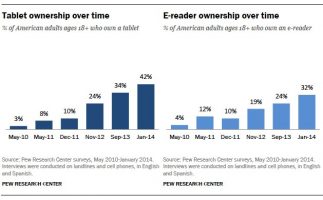Week 4 Discussion Post
September 16, 2014
Read this:
and then read this:
and refer to your Class 8 reading assignment:
Answer the following:
- Do you agree with this week’s readings that print is not dead? As long as you prove your viewpoints, use cites/online articles (linked) to prove any facts/support ideas you have, you get full points.
- What’s a publication that you now read solely online? What circumstances led you to change from print to online?
- Are there any publications that you still read in print? Why? They don’t have to be mainstream. They could be as simple as a department update memo/company newsletter etc.
Is print dead? The question has loomed for decades with each advent of a new consumer digestible medium.
When radio took off, newspapers and printing were said to vanish. Then television hit the airwaves and critics said radio AND print would be dead. Most recently, with the invention of the World Wide Web the discussion still lingers as to how long print can survive. The New York Times ran an article several years ago (Dead Again – 8/10/2012) that shared both the history of pending doom for print.
I don’t agree that print is dead. Like all media, print continues to evolve, both with innovation and consumer behavior. Whether it’s the rapid expansion and adoption of tablets/ereaders, or the increase in variable digital printing presses, print continues to grow and change to fit the needs of consumption.
According to a recent Pew Research study, more than 42% of adult Americans now own a tablet handheld device, while 32% of adult Americans have access to an ereader. While tablets and ereaders are multi-function devices, they easily support applications to read digital versions of books and magazines.

Tablet & eReader Chart
These digital platforms allow for ease-of-use to publications that are both created originally for digital digestion, or converted from their original print format.
Personally, I almost read books entirely through my Amazon Kindle ereader. However, I transition back and forth between print and digital edition of my favorite newspapers and magazines. For example, I check OrlandoSentinal.com every day, and if I have time at lunch, I pick up the printed edition that’s delivered to my office, where I can read the content that’s only available to subscribers.
Additionally, I read almost exclusively WIRED magazine on my tablet, even though they insist on sending me a hard copy of each issue. The digital version incorporates even greater multimedia, including animated infographics, real-time social feeds, integrated video and more. Coincidentally, WIRED has covered the subject throughout the years

Communigator
However, there are a few publications that I still receive printed and don’t easily have access to the digital equivalent. The College of Journalism and Communications Communigator is an example I receive in print and only read the hard copy. Additionally, I receive the general alumni magazine hard copy. I read both publications in this format, mostly because it’s delivered directly to my mailbox with no effort on my part.
This is why I don’t think print will ever die. We like the tangible over the abstract. Additionally, the pass-along value is huge in any printed piece as it’s not easy for me to share my digital version of a magazine from my iPad, but I certainly pass along my printed copy to a friend or colleague. Print will evolve as it has and consumers will adapt, as they have.
Post Tags:
Digital Layout, Is Print Dead, VIC5325,